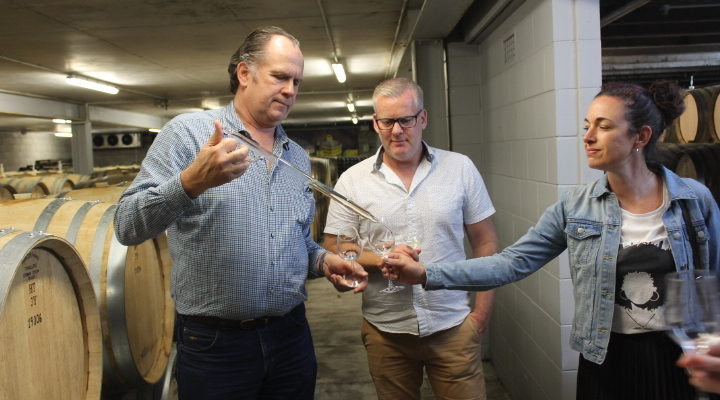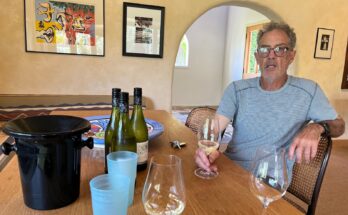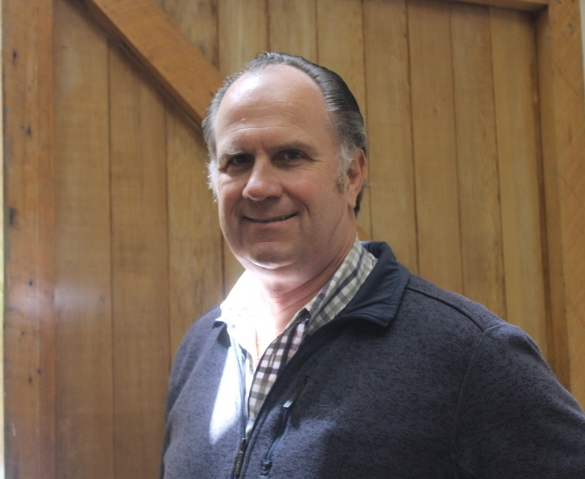
An occasional series where we corner the best of New Zealand’s winemaking talent. Today we talk with Michael Brajkovich.
So, a New Year, and, in fact a new decade! But now it’s back to work time… I’ve arranged to meet the maker of my favourite wine (Matés Vineyard Chardonnay) on the first day back to it after a decent Festive Break. I’d been to a few events featuring Kumeu River in the last year, but never got around to talking to Michael; and a proper sit down and discussion seems overdue. For the Winemaker Series, you will see that I’ll be asking a few of the same questions to each person as we go – and we’ll see what each has to say.
WineFolio: Winemaking – would you say this is a “Creative” field that you work in, or “Scientific”?
Michael Brajkovich: In the first instance, certainly Scientific. Because you need to have tools, and the ability to use that medium – artists have their medium, and grapes is our medium – so having some degree of mastery over that is very important. Then, once you’ve got past the basics, there’s scope to bring out the artistry. I guess that does take time. So it takes a lot of tastings and comparisons – learning from other regions and other winemakers; just learning how to do that, and bring out the best. In most situations, in other countries, that’s been done over a very long period of time. And a lot of it’s handed down – you learn from your mentors.
WF: And yet, New Zealand has got here quite quickly?
MB: That’s because of Science. We’re not just working with ‘what the Old man told you’. All of us have had the benefit of some kind of education, and speeding things up from that perspective. The progress that Australia and California have made is largely due to the influence of science. Right from the 1930s, their governments recognized that they really needed to invest in education, and in research. To a certain extent in New Zealand as well, but on a much smaller scale; and it’s good to see that type of thing is continuing – with the new Marlborough Centre that’s being established.
WF: So when you wanted to follow in the family business, was Roseworthy College pretty much the only choice for you to study?
MB: No, there were two by that stage. There was Roseworthy, but also Riverina College, that became Charles Sturt University – in Wagga Wagga. In the end I ended up going to Roseworthy because Bryce Rankine knew my father. He was a Wine Researcher at the Wine Institute in Adelaide for many years and he said I should come to Roseworthy. I’ve never regretted that, it was a fantastic experience. There was nothing here specifically targeted at Oenology. I also looked at the Food Technology course at Massey University. Lincoln had some aspects. Now you have many more options within New Zealand.
WF: Did you come back from that and go straight into the family wine business?
MB: Yes, my first vintage was 1982. The company was established – we had winemakers before. The assistant winemaker who was there before, Nigel Tibbits, is still with us – so he’s been here in this job longer than I have. His experience and knowledge is fantastic. It’s been a real benefit having him around to do all the things that we want to do.
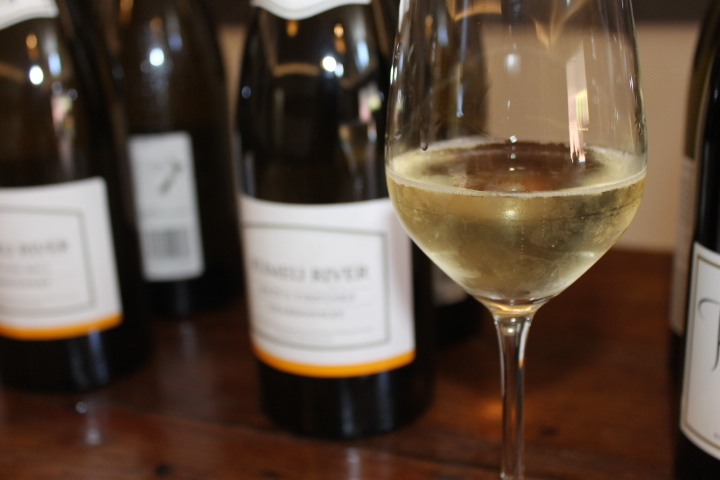
WF: Back in day, you were focused on – was it – one great white and one great red wine?
MB: That was Dad’s idea. One really good dry red, one really good dry white wine – a bit like a property in Europe would do. But I then also had the opportunity to travel – to France, went to Bordeaux but also travelled around a lot of the regions and just saw how things happened there. I got a real feel for the history – why these places exist, how they work; which was quite foreign to what we have here. I took a very European perspective, applying that knowledge to our situation. The education I got at Roseworthy was fantastic – from a technological point of view – we had lots of really good teachers.
But what Roseworthy was really good at was teaching the basics and principles and leaving it to the individuals to apply those the way they saw fit. A lot of the things that we started to change here in the mid-80s – for example, moving into wild yeast fermentation; using malolactic fermentation in white wines – which was just unheard of at the time. Doing things like barrel fermentation. That was an unusual thing. Whole bunch pressing grapes… nobody did that. We’ve learnt things very quickly and changed things up very fast.
WF: You changed things in the vineyard as well – the lyre system for example?
MB: Yes, that was my contribution to it. My brother would now not like to have it (laughs). But it’s there, and I think now we could achieve the same type of things with narrow rows; but at the time we didn’t have that option. We didn’t have the small tractors or the tractors that go over the row and stuff like that, so you had to adapt the current vine spacing with some changes to the canopy. A lot of that I learnt from Richard Smart at Roseworthy. I did my third year project under him – on Vineyard Canopy Management & Manipulation.
WF: And then the Merlot went?
MB: Merlot was a bit of a pivotal moment. It was in this office one day, and Dad had a visit from two guys from Corbans Wines – Bob Matthews and Kevin Petersen. Rothmans had bought Corbans and they wanted to get rid of their Auckland vineyards. They had a big one in Taupaki and a big one in Kumeu. And they came in and said “we want to sell these vineyards and we think you should buy them”. Dad gulped, but we went and had a look. And we decided that Kumeu was the most attractive because it was just up the road; but the big attraction was that it had a 20 acre block of Merlot. That was the most significant Merlot planting in New Zealand at the time.
So it was an exciting time. We bought the land in ’83 and Dad managed to sell most of the grapes to another property. And we ended up with a large – 100 acre – vineyard. Not all of it was good – Merlot was the best part of it. It had Muller Thurgau on it and a lot of Palomino… it had a variety called Golden Queen. But then things got really tough a few years later – the economy tanked and interest rates went through the roof, they hit 19%. So Dad decided we’d sub-divide it; and sold off all except the Merlot. Then a few years later we were able to buy one back, so now we have two 20-acre blocks there.
And the Merlot’s all gone. We really thought Merlot was going to be the great variety for us – I’d then had the opportunity to work the ’83 vintage at Jean-Pierre Moueix at Pomerol and St. Emilion – Milan went and worked there as well in 1987. Things happened very, very fast. And with that first Merlot we produced – that won a Gold medal – was the first wine ever labeled with the Kumeu River label. Up until then we were San Marino Vineyards, and our first significant wine won a Gold medal, which was fantastic. Subsequent to that, we realised that Merlot in a good year is pretty good, but there are years where it just doesn’t ripen very well here.

At the same time we started planting other blocks of land that we had here in Kumeu, and we planted Cabernet Sauvignon, Cabernet Franc, Sauvignon Blanc – and Chardonnay. And of those four varieties it was the Chardonnay that shone all the time. Eventually all those other varieties got pulled out and got replaced with Chardonnay and a bit of Pinot Noir. Chardonnay is early ripening, and the other grape variety in Burgundy is Pinot Noir; so we thought that should do quite well too. And it does. We don’t have a huge reputation for our Pinot here but…
WF: I think it’s pretty good! Why do you think that is? Because the Chardonnay is extremely well regarded – worldwide as well as NZ?
MB: I suppose it’s a bit like parts of the Cote du Beaune that make primarily white wine, so Puligny, Chassagne, but also they make red. They’re just not very well known for red. I think we’re in that same kind of situation. The reds are pretty good, but they’re not our main thing. And our Chardonnay certainly is.
WF: And the other thing that I really believe that Kumeu River could be known for in the future is the Crémant. I think that’s wonderful. You obviously already have the Pinot Noir here to do that. And I do believe that New Zealand has the opportunity to excel at sparkling wine – I mean, no-one thought England would make decent bubbles, but now they are hitting their straps…
MB: It’s an interesting thing with the sparkling; because years ago Dad used to make a lot of sparkling wine. Not particularly good, but quite commercial, and did very well with it. But it was just too hard – to go down the traditional method. Everything about it is difficult. So we didn’t do it.
It’s better now – because we’ve done it now… and we know more about it. We’re very fortunate to have Tony Soljan just up the road who has a lot of the gear that we can borrow; but without that it would be impossible. You just have to invest too much money for the kind of volume that you can produce. But it’s been a long time that we’ve thought that a lot of our vineyards could produce pretty good sparkling wine, but never got around to doing it. For sparkling you have to sit down and work out the economics, and you kind of go… nah!
Really one of the impetus for the Crémant… Mum and I were in New York, at the Wine Spectator Wine Experience in 2009 – 10 years ago. And we’re at a late night function in a penthouse with a view of the Chrysler Building. Hugh Johnson had come to New York and he hadn’t seen us for years, and we sat down and had a great chat. We had the 2004 Matés Vineyard Chardonnay with us and he looked across and said “have you ever thought of making bubbles?” Just that little bit of encouragement – because he saw something in that older bottle of wine that was something like you might get in a vintage champagne.
So, a couple of years later (and I didn’t really tell anyone) we picked a little bit of fruit early and made it into some sparkling base. It was an experiment even then – if things hadn’t worked out we would have just blended it away – but the wine looked good. So we decided to bottle it. We got a lot of really good advice from Rudi Bauer, and also Sarah Burton who was, at the time, at Cloudy Bay – both sparkling experts – and got a lot of ideas of what to do.

WF: I’m amazed just how much of a Community, the New Zealand wine industry is.
MB: It’s all about the bigger picture. New Zealand wine is so small in the world – anything that we can do to improve the standing of New Zealand wine we’re going to benefit from as well. The best example I ever saw of that was Robert Mondavi. He was a fantastic guy. I remember doing a wine dinner with him one night – so we had Mondavi wines and Kumeu River wines. I got up and talked about the Kumeu wines; and he got up and just talked about the Kumeu wines! He was always very generous in his talking about other people’s wines as well as his. And all the boats lifted on the same tide.
WF: What about Burgundy – what do they think of Kumeu River?
MB: We’ve had some very nice comments from people over there. We’ve had people come and work for us from that part of the world, who had seen our wines before and thought they were in a Burgundy style; but here is something a bit different, and what can we learn from that? So that’s been really good.
WF: What do you think of New Zealand Pinot Noir, generally?
MB: I think it’s outstanding. I judged in the Air New Zealand Wine Awards – I was 5 years as Chairman – and every year the outstanding class was always Pinot Noir. It’s always the biggest in terms of Gold Medals awarded. After that, Chardonnay; and Chardonnay wasn’t getting the recognition it really deserved. The Pinot Noir – it’s not necessarily in a Burgundian style either, but outstanding.
WF: Telling the story of New Zealand wine to the world – is that a hard thing to do? Kumeu River has been going long before New Zealand Pinot Noir made waves; and about the same time as Marlborough Sauvignon Blanc became a global sensation?
MB: When we started with our agents in the USA and UK, was 1988, and at that stage Cloudy Bay had started – and they went very well. But people didn’t know a lot about New Zealand, and we were very fortunate when we went into the United States that our agents there promoted us in a way that people thought we were somewhere else – somewhere in Australia… it wasn’t then about New Zealand Chardonnay – there was no category – it was about Kumeu River Chardonnay. I remember a lot of restaurant lists in the late ‘80s – if there was New Zealand wine on the list in the US, it was Cloudy Bay Sauvignon Blanc and Kumeu River Chardonnay – for a long time! Then, of course, other people starting coming in.
WF: Have you thought of doing the sort of thing where you take two barrels and make a ‘Masterpiece wine’? And what do think of that sort of thing?
MB: No. It’s not of interest to us. All of our wines are of a reasonable volume that people can get hold of, and we’re not interested in making two barrels of anything. Our portfolio here – the Matés and the Hunting Hill are around 1000-1200 cases each, so a reasonable quantity; but we have to be careful how it’s priced. A lot of Burgundy producers do produce one or two barrels of a particular appellation, but that’s because they’ve only got a couple of rows and that’s all they can make.
However, now that we’ve got the Rays Road Vineyard – that’s really exciting. It’s all on limestone and we’re starting to see real limestone characters coming through.
As the years progress we’re going to get more and more Chardonnay off that – we’ve already pulled out more than four hectares and replanted with two clones of Chardonnay – 548 (from Burgundy) and UCD115 (from California, thanks to the late Warren Moran), which are very good performers here – and we’ll definitely put some Mendoza in as well.
WF: What about awards and shows – you don’t seem to chase Gold medals?
MB: No. We did, back when we were building the brand. The Gold medal that we got with the Merlot was very instrumental at the time, and we entered Chardonnays through the ‘80s and did OK. I’m still a great advocate of the Show system. I think it does work, and it really comes down to who you’ve got judging and how it’s run. For example, here, the best Pinots do stand out, and win time and time again. The background to that however, is that not everyone enters; so you don’t necessarily have all the best wines.
WF: I have a couple that I think are excellent – for example the Fine Wines of NZ List – if you just sat and worked your way through that, you’d be doing OK!
MB: Yes, that’s a really good list. And very rigorous tasting protocol and programme. To get on that list, you have to jump through a lot of hurdles; and it is a list where a lot of people on there would never enter a Wine Show.
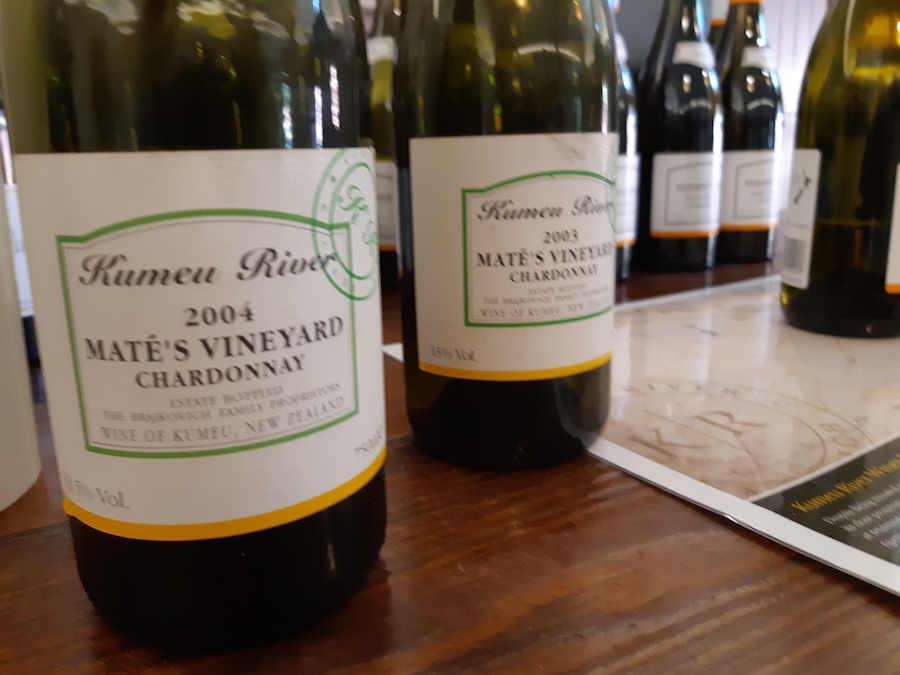
WF: Going back to the winemaking; and a question I ask all the winemakers I talk to.. is there a point in the process where you get ‘a feeling’ about the wine at hand. Is there a moment where intuition plays a big part?
MB: A lot of it is that. I think it all comes down to a lot of small details. And nothing happens purely by accident. It’s the results of someone’s efforts the whole way through. So if you go down to the cellar and taste and go “Wow, where does that come from?” The answer is a whole lot of different people. That vineyard was planted, looked after, harvested and then through the whole process. It’s the sum of those processes and every one needs to be done correctly.
We like to have our own vineyards. We do purchase from growers but in every case we have a big input into how those grapes are grown. That’s really important for our best wines. The Coddington has got better every year – but all the vineyards are getting better with age too. The stunning one really is the Matés, because ten years ago we thought that we’d have to start again – it’s got a lot of leaf-roll virus in it, and you’re thinking it’s going to fall over any day; but it just keeps going and we keep looking after it.
WF: One of the last things I wanted to talk to you about is Climate Change. You mentioned Richard Smart earlier, and he seems to be heard more now for his opinions on Climate Change than viticulture. What are your thoughts?
MB: We are very fortunate in being where we are, that the effects of Climate Change have not been as dramatic as they have been in, say, Australia. In terms of harvest dates – ours haven’t changed much at all. We’re still picking Chardonnay in the first week of March.
So we’re not looking at changing varieties or the way we do things, or alternative packaging. Glass is still, for us, number 1. Cans, I know have been very successful for beer. I don’t know if we can say the same thing about wine – yet. You can’t close yourself off, but for the time being we’re quite happy with what we’re doing.
In terms of CO2 – as well – all that CO2 was sequestered by the vines in the first place, through photosynthesis. And then, during fermentation, a third of it, goes out as CO2 gas; but the other two-thirds is locked into alcohol. It’s part of a cycle. We’re not contributing any more or less than any other agricultural product. Even these guys who are capturing CO2 and producing Potassium Bicarbonate and/or Sodium Bicarbonate – which is then used in other industries… what happens to that? You’ve just moved the roadblock a bit further down. There’s a big chunk of Climate Change that we can do nothing about, and we need to accept that.
I’m often asked the question about what is the biggest challenge to the wine industry today; and as well as Climate, for me, it’s the Neo-Prohibitionists. That new puritanism that’s seen a decline in alcohol consumption. That’s worrying, because who’s going to drink our wine?

